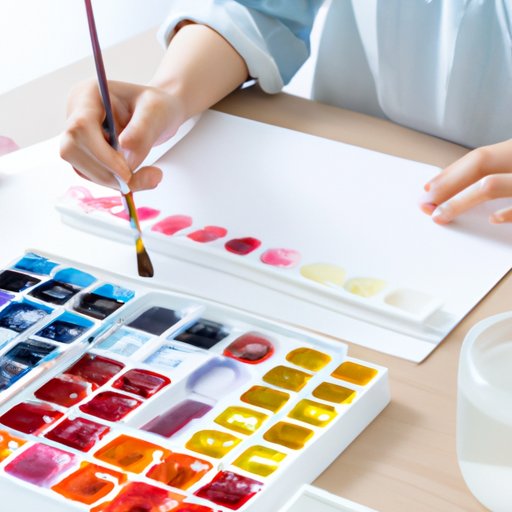
I. Introduction
Watercolor painting is a beautiful, versatile art form that has delighted artists for centuries. With its fluid, translucent layers of paint, and the endless possibilities for texture and color, it is no wonder that so many people are drawn to this medium. Whether you are an experienced artist or a complete beginner, watercolor painting is an excellent way to express your creativity and connect with the world around you. In this article, we will provide a comprehensive guide to watercolor painting for beginners – from selecting your supplies to techniques and inspiring ideas.
II. Step-by-Step Tutorial
To begin, you will need to gather your materials. The most important items include watercolor paints, brushes, and paper. You should also have a clean, flat surface to work on, such as a desk or a table. Once you have your supplies, set up your workspace and get ready to paint! Start by selecting the surface that you want to paint on. You can use a pad of watercolor paper, or you can cut individual pieces to your desired size.
The order in which you paint is very important. Begin by prepping your paper. If you are using a pad, simply remove a sheet and tape it to a board on all four sides. This will prevent your paper from warping as you use water and paint. Next, start with the lightest colors of your composition and work your way up to the darker colors. Remember that watercolor painting requires layering, so you will need to allow each layer to dry before adding another on top.
When painting with watercolors, it is essential to know how to create textures in your work. To create a textured effect, you can use different brushes to create different effects. For example, a flat brush is suitable for smooth, even washes, while a round brush is excellent for smaller areas and detail work.
Another essential technique in watercolor painting is using masking fluid. This unique material is added to the areas on your painting that you would like to protect from paint. Once dry, you can paint over the masking fluid with watercolor without worrying about bleeding or blending.
Finishing your painting is just as important as starting it. Once you have applied the final coat of paint, allow the work to dry naturally. Once completely dry, mount the painting by matting and framing it, or use a clear acrylic spray to protect your work from fading or damage.
III. Highlighting the Basics
Understanding the principles of color and how to use them is crucial for success in watercolor painting. Keep in mind that watercolor paints react differently to each other than to other forms of paint. It is important to know how to blend, layer, and shade your colors on paper.
As you progress in your painting, experimenting with different brush strokes and techniques will improve your skills. Incorporating different brush tips and shapes into your work can create different effects and textures.
Learning to create washes is an essential skill in watercolor painting. Washes are the basic building block of a watercolor painting, creating gradients and transitions between colors.
IV. Inspiring Ideas
There are so many different styles of watercolor paintings to explore. From florals and landscapes to abstract art, the possibilities are endless. If you need inspiration, try out some different watercolor painting ideas to get you started.
Creating simple watercolor paintings can be enjoyable and calming, requiring nothing more than a few simple shapes and some colors. There is no right or wrong way to paint watercolors, making it the perfect medium for experimentation and exploration.
V. Expert Advice
Expert watercolor artists have been crafting beautiful paintings for years. Learning from their experiences is an excellent way to expand your skills. Following in their footsteps can be a great way to gain inspiration and learn new techniques.
Connecting with artists through online platforms or at local painting communities can provide an opportunity to solicit advice or criticism from those with more experience. Take advantage of these opportunities and put experienced advice to work in your paintings.
VI. Troubleshooting Guide
As you become more comfortable with watercolor painting, you will inevitably encounter common problems. Understanding how to prevent or fix these problems is an important part of advancing your skills.
Issues such as color bleeding or uneven washes can be prevented and corrected with the proper knowledge and techniques. Choosing the right pigments for your artwork will also help you paint with confidence and make your painting stand out.
VII. Practice Prompts
Practice makes perfect, and in watercolor painting, this is no different. Incorporating exercises into your routine not only allows you to develop your skills, but it can also be enjoyable and therapeutic.
Try painting the color wheel, creating a monochromatic painting, or painting a still life. These exercises will help you to become proficient with different color schemes and to develop a greater sense of depth in your work.
VIII. Conclusion
In conclusion, watercolor painting is a beautiful and rewarding art form that you can enjoy as a beginner. With the right materials, techniques, and inspiration, you can create stunning pieces of work that will capture the essence of your creativity and imagination. Remember to keep practicing, experimenting, and pushing yourself out of your comfort zone.





